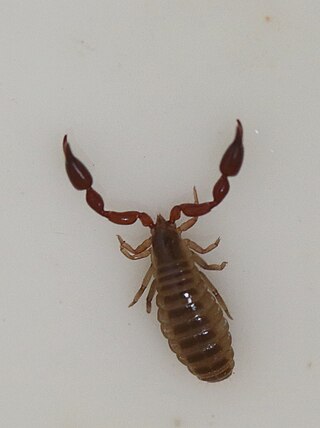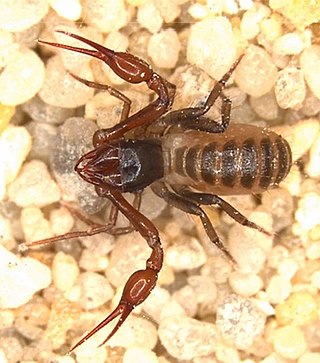
Pseudoscorpions, also known as false scorpions or book scorpions, are small, scorpion-like arachnids belonging to the order Pseudoscorpiones, also known as Pseudoscorpionida or Chelonethida.
Atemnidae is a family of pseudoscorpions, first described by Kyukichi Kishida in 1929.

Oratemnus is a genus of pseudoscorpions in the family Atemnidae.

Pseudotyrannochthoniidae is a family of pseudoscorpions, belonging to the superfamily Chthonioidea. It represents the most basal and primitive group of living pseudoscorpions, with less than 100 species in 6 genera. Living members of the group have a strongly disjunct distribution, likely reflecting ancient vicariance, occurring in Australia, Asia, Southern Africa and Madagascar, Western North America and southern South America. Fossils species are known from the Eocene Baltic and Bitterfeld amber, which represent members of extant Asian genera.
Synsphyronus elegans is a species of pseudoscorpion in the Garypidae family. It is endemic to Australia. It was described in 1954 by Austrian arachnologist Max Beier.
Sundochernes is a genus of pseudoscorpions in the Chernetidae family. It was described in 1932 by Austrian arachnologist Max Beier.
Sundochernes australiensis is a species of pseudoscorpion in the Chernetidae family. It is endemic to Australia. It was described in 1954 by Austrian arachnologist Max Beier.
Sundochernes dubius is a species of pseudoscorpion in the Chernetidae family. It is endemic to Australia. It was described in 1954 by Austrian arachnologist Max Beier.
Calymmachernes is a monotypic genus of pseudoscorpions in the Chernetidae family. It is endemic to Australia. It was described in 1954 by Austrian arachnologist Max Beier.

Conicochernes is a genus of pseudoscorpions in the Chernetidae family. It is endemic to Australia. It was described in 1948 by Austrian arachnologist Max Beier.
Conicochernes crassus is a species of pseudoscorpion in the Chernetidae family. It is endemic to Australia. It was described in 1954 by Austrian arachnologist Max Beier.
Conicochernes globosus is a species of pseudoscorpion in the Chernetidae family. It is endemic to Australia. It was described in 1954 by Austrian arachnologist Max Beier.
Australochelifer is a monotypic genus of pseudoscorpions in the Cheliferidae family. It was described in 1975 by Austrian arachnologist Max Beier.
Protogarypinus is a genus of pseudoscorpions in the Garypinidae family. It is endemic to Australia. It was described in 1954 by Austrian arachnologist Max Beier.
Protogarypinus giganteus is a species of pseudoscorpion in the Garypinidae family. It is endemic to Australia. It was described in 1954 by Austrian arachnologist Max Beier.
Beierolpium bornemisszai is a species of pseudoscorpion in the Olpiidae family. It is endemic to Australia. It was described in 1966 by Austrian arachnologist Max Beier.
Beierolpium squalidum is a species of pseudoscorpion in the Olpiidae family. It is endemic to Australia. It was described in 1966 by Austrian arachnologist Max Beier.
Olpium australicum is a species of pseudoscorpion in the Olpiidae family. It is endemic to Australia. It was described in 1969 by Austrian arachnologist Max Beier.
Heterolophus australicus is a species of pseudoscorpion in the Chthoniidae family. It is endemic to Australia. It was described in 1969 by Austrian arachnologist Max Beier.
Anaulacodithella plurisetosa is a species of pseudoscorpion in the Chthoniidae family. It is endemic to Australia. It was described in 1976 by Austrian arachnologist Max Beier.



